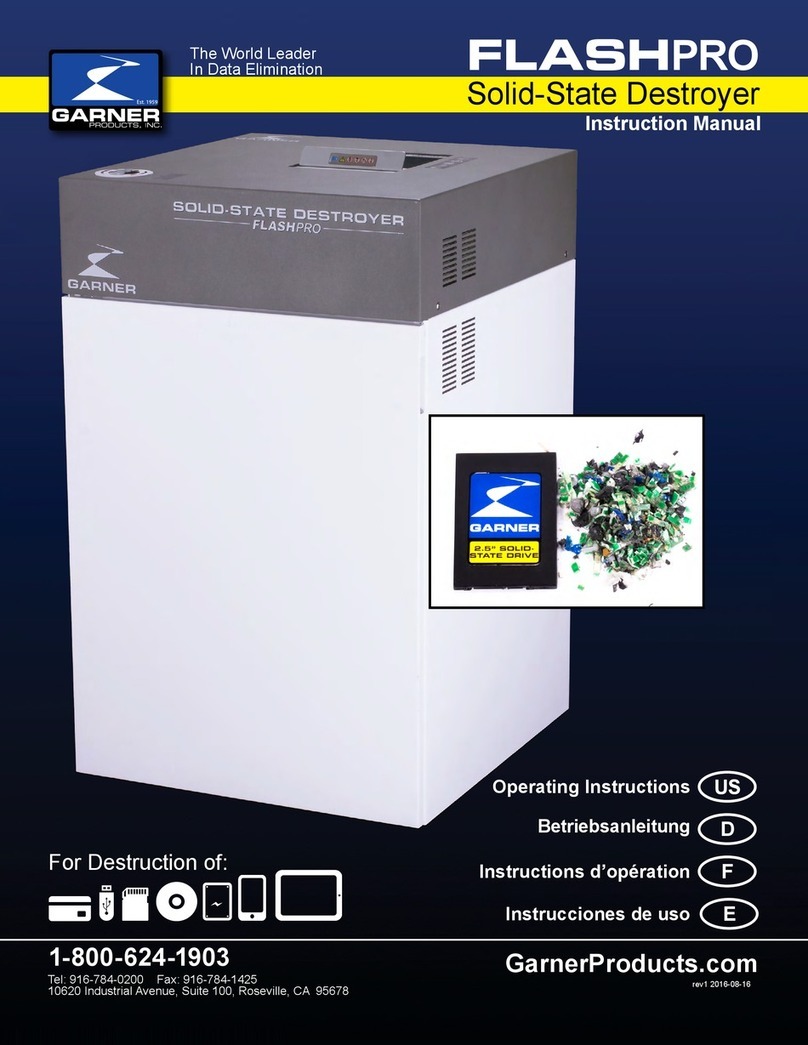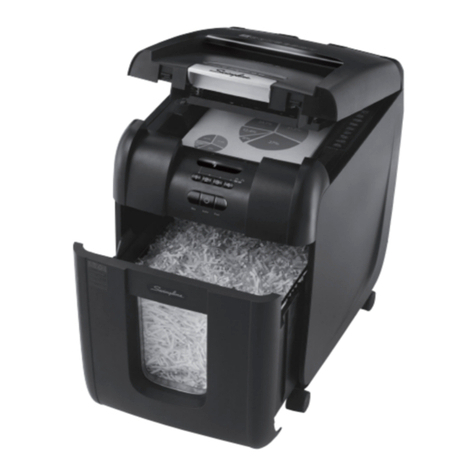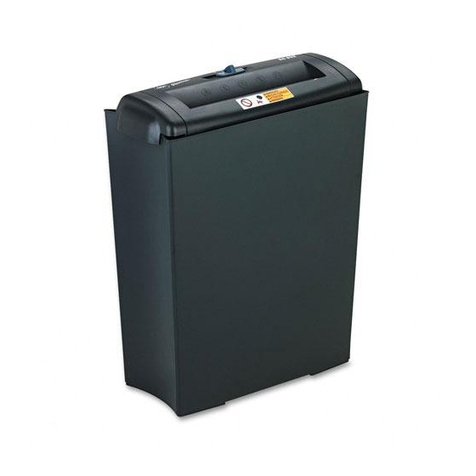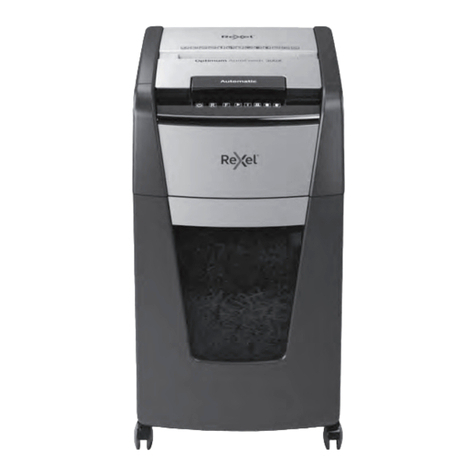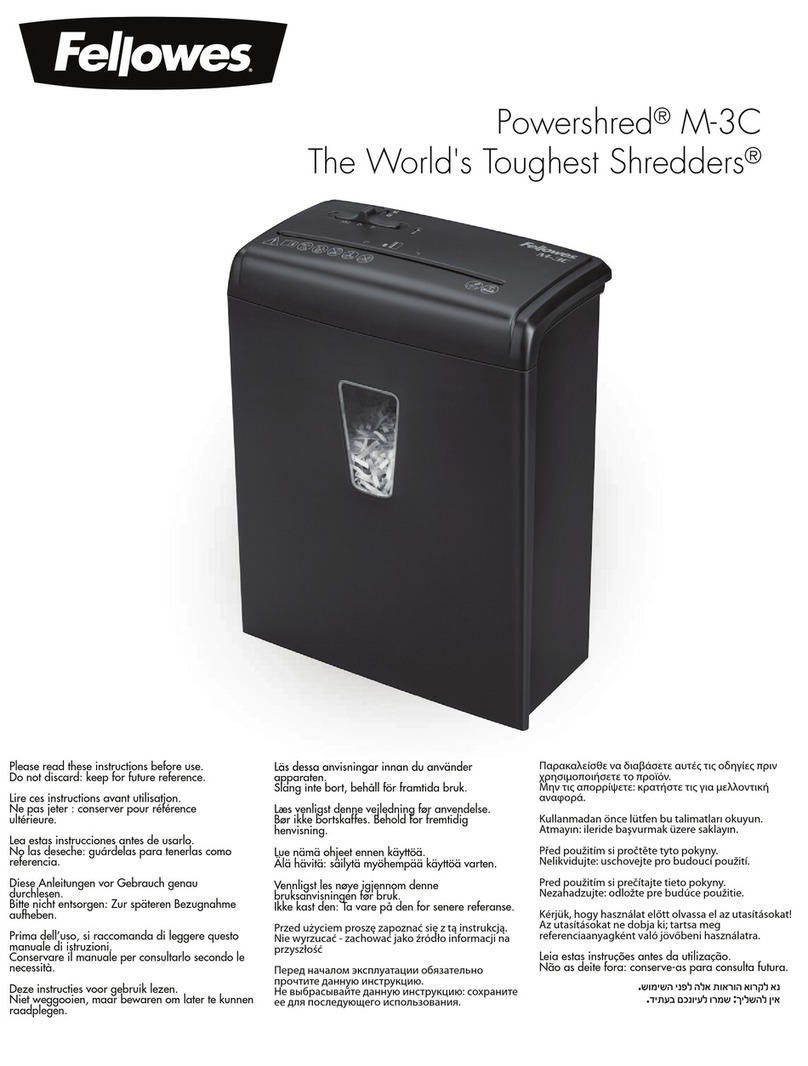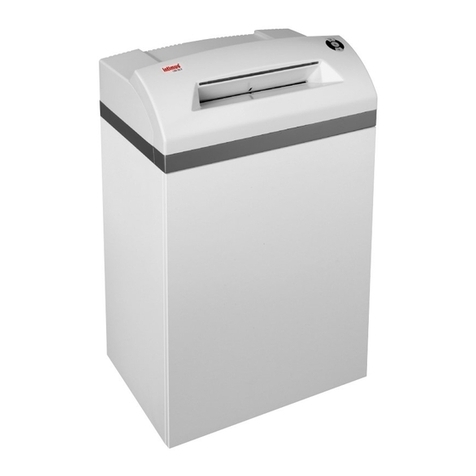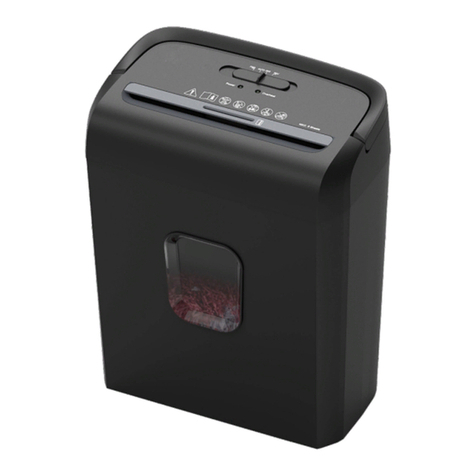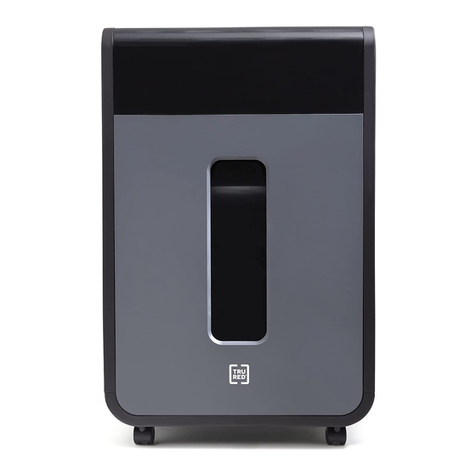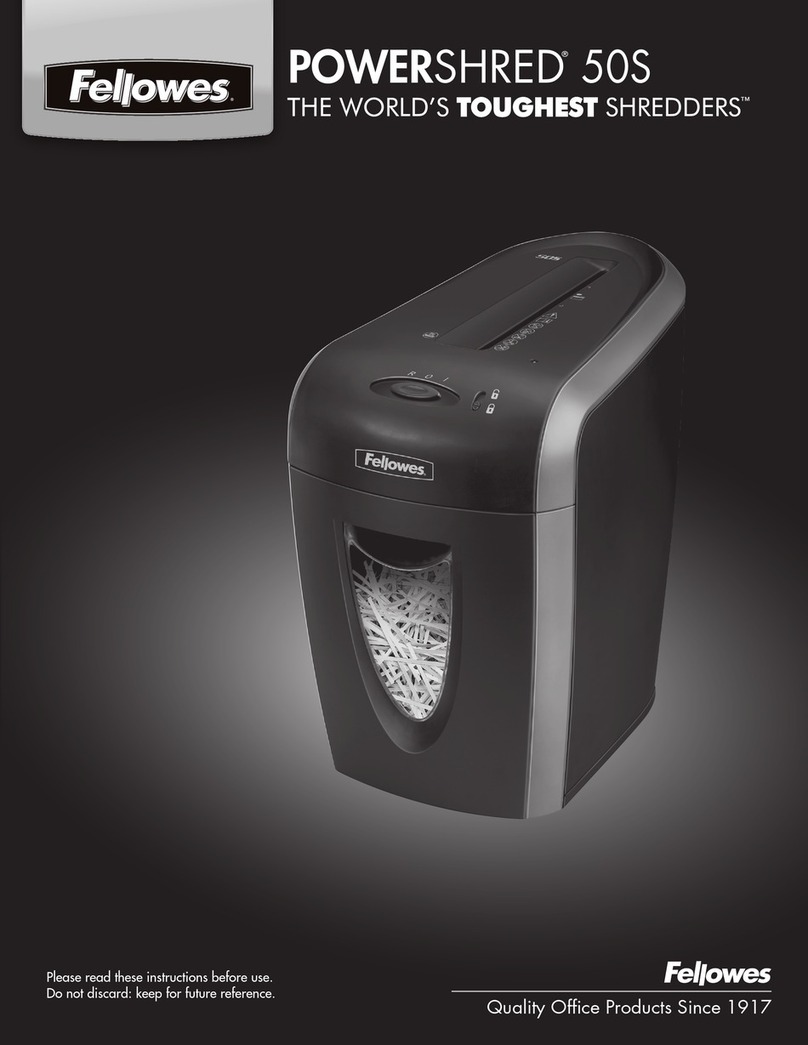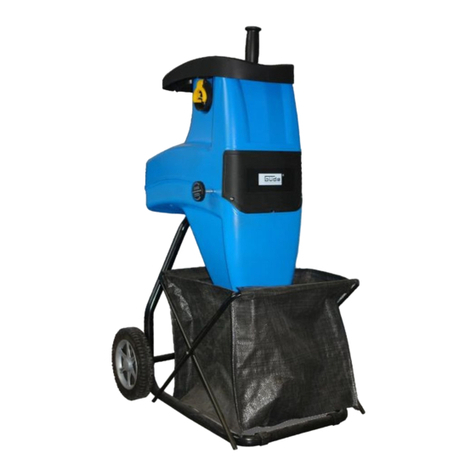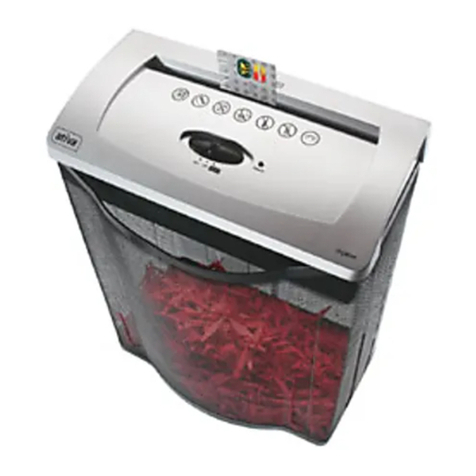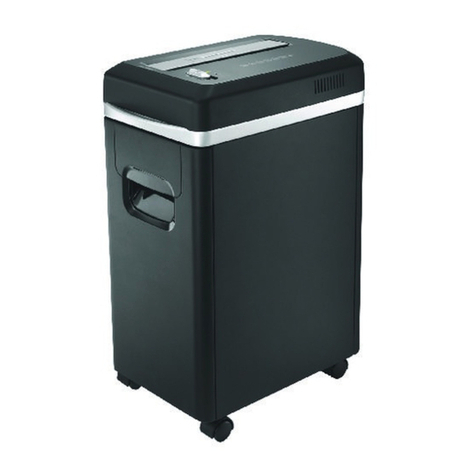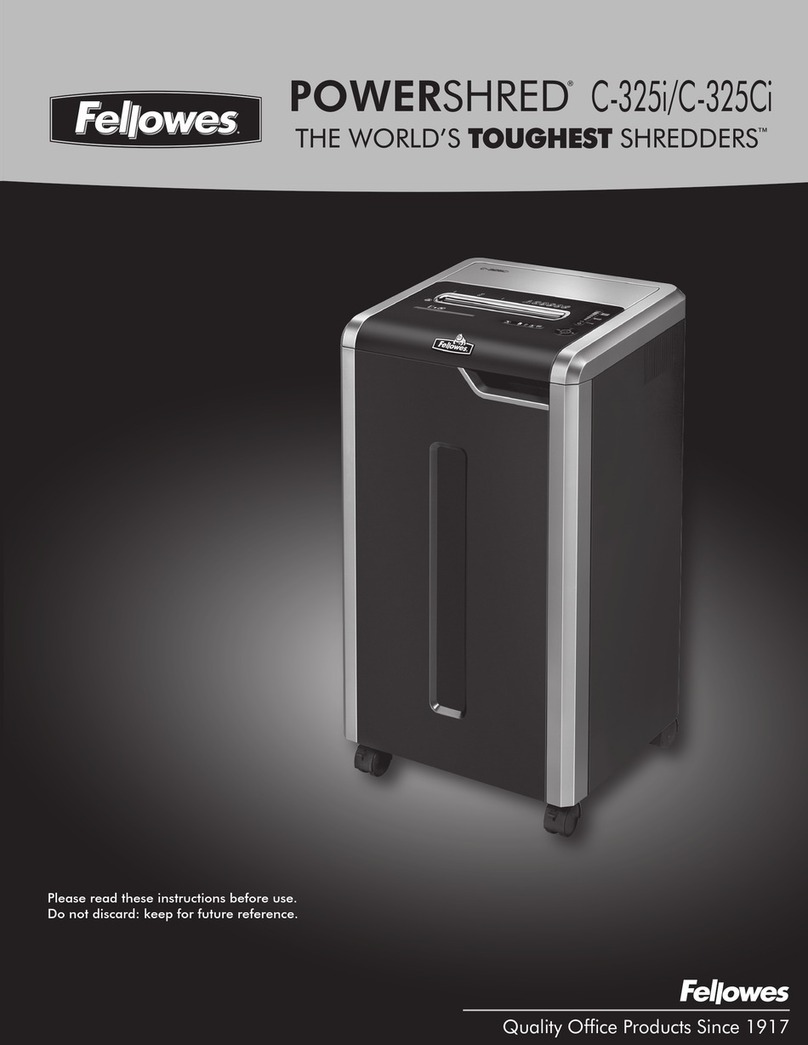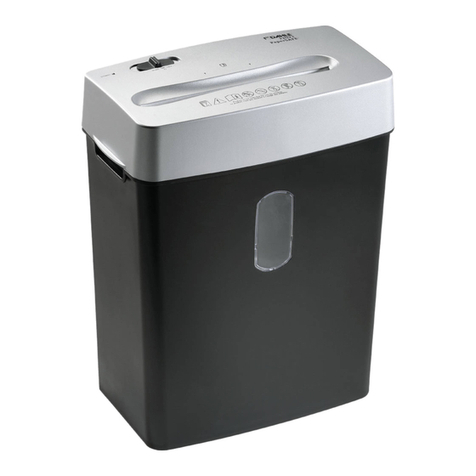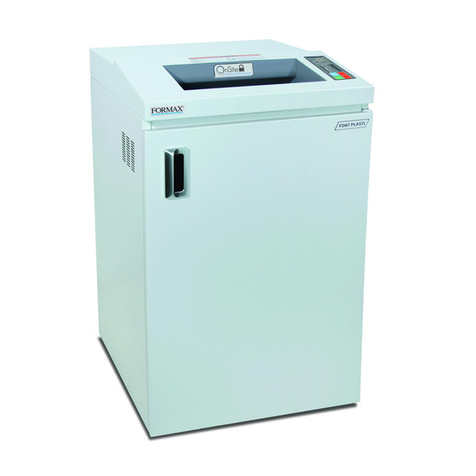F
ENTRETIEN
COMMENT REMEDIER AUX PETITES PANNES
NETTOYAGE DES
CELLULESPHOTOELECTRIQUES(g.4):
Il est possible que des morceaux de papier restent
dans la rainure d’admission (par ex. après un
bourrage de papier) et empêchent la barrière
lumineuse « occupée » d’arrêter l’appareil.
Il est possible d’enlever ces morceaux de papier
ou de nettoyer les cellules photoélectriques, soit en
introduisant une nouvelle feuille de papier dans le
bloc de coupe, soit en déclenchant la marche arrière
et en passant brièvement un pinceau sur les « yeux »
des cellules photoélectriques.
MAINTENANCE DU BLOC DE COUPE
(coupe croisée):
Les blocs de coupe Cross-Cut doivent être
lubriés après avoir fonctionné un certain
temps. Si le voyant de contrôle (7)
s’allume, procéder comme suit:
Répartir un peu d‘huile spéciale jointe à la livraison
sur une feuille de papier et introduire cette dernière
dans la bouche d‘alimentation du bloc de coupe.
Le papier est introduit et graisse ainsi le bloc de
coupe.
Remarque:Andefairedisparaîtrelesvoyantsde
contrôle,ilconvientdevaliderlandel’opération
delubricationdublocdecoupecommesuit:
- Ouvrir la porte jusqu’à ce que le voyant de contrôle
(8) s’allume. Les voyants de contrôle (7) et (4)
clignotent.
- Actionner la touche de marche arrière (4) et la
maintenir enfoncée jusqu’à ce que le voyant de
contrôle (7) s’éteigne.
- Refermer la porte.
Le bloc de coupe commence maintenant
automatiquement un cycle de nettoyage (course
marche avant/course marche arrière) et ensuite il
s’éteint. La machine est à nouveau prête à fonctionner.
Pour recommander ultérieurement de l’huile spéciale,
voir « ACCESSOIRES SPECIAUX ».
MODE AUTOMATIQUE
ECONOMIE D’ENERGIE:
Lorsque la machine n’est pas utilisée pendant un
certain temps, elle s’éteint automatiquement après
environ 5 minutes. Le voyant LED de la touche de
fonction (1) indiquant « prêt à fonctionner » s’éteint.
Actionner brièvement la touche de fonction pour
remettre la machine en marche.
ENTRETIEN
BOURRAGE DE
MATERIAU DANS L’APPAREIL:
[Fonction Auto-Reverse]
Si une quantité trop importante de matériau
provoque un bourrage, la machine réagit comme
suit:
- Le bloc de coupe se bloque, se déplace
ensuite un peu vers l’arrière (ce qui libère le
matériau) et s’arrête. Le moteur s’éteint. Le
voyant de contrôle (6) s’allume.
Procéder comme suit:
- Enlever le papier introduit.
- Le coupe de bloc avance maintenant
automatiquement et broie les résidus de
papier restés dans le bloc de coupe. En cours
de marche avant, le voyant LED de la
touche marche avant (2) s’allume. Le voyant
de contrôle (6) s’éteint.
- Poursuivre le broyage avec une quantité de
papier plus faible.
BARRIERE LUMINEUSE OCCUPEE
LORS DE L’OUVERTURE DE PORTE:
S‘il y a encore du matériau dans la bouche
d‘alimentation en ouvrant la porte, le moteur se
coupe et le mécanisme de coupe s‘arrête. Le
voyant de contrôle (6) luit.
Fermer la porte et valider l’état en actionnant
brièvement la touche de marche avant (2). Le
matériau présent passe dans le bloc de coupe
et est broyé.
BARRIERE LUMINEUSE OCCUPEE
LORS DE LA MISE EN MARCHE:
S‘il y a encore du matériau dans la bouche
d‘alimentation en enclenchant la machine, le
voyant de contrôle (6) luit.
Retirer le matériau et valider l’état en actionnant
brièvement la touche de marche avant (2).
PROTECTION DU MOTEUR:
Le moteur s’éteint s’il est surchargé. Le voyant
de contrôle (9) s’allume.
Après une période de refroidissement
d’environ 15 à 20 minutes (suivant le modèle
et la température ambiante), il est possible de
redémarrer l’appareil.
DYSFONCTIONNEMENT ELECTRIQUE:
Il y a dysfonctionnement électrique si le voyant
de contrôle (9) clignote parallèlement avec le
voyant LED de la touche de fonction (1) ou si
seul le voyant de contrôle (8) clignote. Il n’est
pas possible de démarrer la machine.
Dans ce cas, veuillez informer votre distributeur
spécialisé.
LISTE DE CONTROLE EN CAS DE PANNES:
Si l’appareil ne fonctionne pas, vérier les points
ci-après:
- La fiche secteur est-elle raccordée au
secteur ?
- La porte est-elle fermée ?
- Est-ce que la corbeille est pleine ?
Suivez les instructions qui gurent sous „VI-
DER LA CORBEILLE“.
- Y a-t-il un bourrage de matériau dans
l’appareil ?
Suivre les instructions « BOURRAGE DE
MATERIAU DANS L’APPAREIL ».
- Le moteur a-t-il été surchargé ?
Voir sous « PROTECTION DU MOTEUR ».
Si aucun des points de contrôle n’est
pertinent, veuillez en informer votre
distributeur spécialisé.
ACCESSOIRES
Largeur de coupe:
702CC (Type 297-4C):4x46 mm (coupe croisée)
702CC (Type 297-2C):1,9x15 mm (coupe croisée)
702SF (Type 297-1CF):0,8x4,5 mm (coupe croisée)
Vitesse de coupe:
702CC (Type 297-4C):0,13 m/sec.
702CC (Type 297-2C):0,13 m/sec.
702SF (Type 297-1CF):0,23 m/sec.
Capacité de coupe:
702CC (Type 297-4C):40-50 feuilles (70g/m2)
702CC (Type 297-2CP):25-30 feuilles (70g/m2)
702SF (Type 297-1CF):8-10 feuilles (70g/m2)
Tension de ligne: 230V/50Hz
120V/60Hz
Fusible:
230V/50Hz: 16 A (à action retardée)
120V/60Hz: 20 A (à action retardée)
Largeur de travail: 405 mm
Niveau de bruit: ca. 52 dB(A)
Puissance: 1,9 kW
Dimensions: (LxPxH): 660x560x1050 mm
Poids: ca. 90 kg
ELIMINATION
ELIMINATION DE LA MACHINE:
En n de vie, éliminez toujours la machine
de façon conforme à l‘environnement. Ne
jetez aucun composant de la machine
ou de son emballage dans les ordures
ménagères.
CARACTÉRISTIQUES TECHNIQUES
10
Désignation Ordre-No.
Distributeur d’huile lubriante #SLS800
#800 Sacs (100) #WHI800
#800 Sacs (50) #WHI800C
#55 Huile lubriante (4 gallon) #SL05G
#55 Huile lubriante (2 gallon) #SL05G-2
Notez: Pour les accessoires et pièces détachées, faites un appel, s’il vous plaît 800-243-9226.

